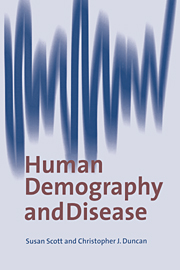Book contents
- Frontmatter
- Contents
- Preface
- Conversion table for imperial to metric units
- 1 Introduction
- 2 Tools for demography and epidemiology
- 3 Identification of population oscillations: a case study
- 4 Density-dependent control and feedback
- 5 Modelling the endogenous oscillations and predictions from timeseries analysis
- 6 Cycles in the grain price series
- 7 Interactions of exogenous cycles: a case study
- 8 Mortality crises and the effects of the price of wool
- 9 Modelling epidemics for the demographer: the dynamics of smallpox in London
- 10 Non-linear modelling of the 2-yearly epidemics of smallpox: the genesis of chaos?
- 11 Measles and whooping cough in London
- 12 Integration of the dynamics of infectious diseases with the demography of London
- 13 Smallpox in rural towns in England in the 17th and 18th centuries
- 14 Infectious diseases in England and Wales in the 19th century
- 15 Prospectives – towards a metapopulation study
- References
- Index
14 - Infectious diseases in England and Wales in the 19th century
Published online by Cambridge University Press: 25 January 2010
- Frontmatter
- Contents
- Preface
- Conversion table for imperial to metric units
- 1 Introduction
- 2 Tools for demography and epidemiology
- 3 Identification of population oscillations: a case study
- 4 Density-dependent control and feedback
- 5 Modelling the endogenous oscillations and predictions from timeseries analysis
- 6 Cycles in the grain price series
- 7 Interactions of exogenous cycles: a case study
- 8 Mortality crises and the effects of the price of wool
- 9 Modelling epidemics for the demographer: the dynamics of smallpox in London
- 10 Non-linear modelling of the 2-yearly epidemics of smallpox: the genesis of chaos?
- 11 Measles and whooping cough in London
- 12 Integration of the dynamics of infectious diseases with the demography of London
- 13 Smallpox in rural towns in England in the 17th and 18th centuries
- 14 Infectious diseases in England and Wales in the 19th century
- 15 Prospectives – towards a metapopulation study
- References
- Index
Summary
The birth and death rates in England and Wales are known with greater certainty after 1837, and the continued growth of the population was in part because of the excess of births over deaths and in part because of a continuing decline in mortality (McKeown & Record, 1962). By the mid-19th century, over half of the population of Britain could be classified as urban and there is clear evidence of a rising standard of living during the second half of the century, with rising real wages, a falling cost of living (Woods & Woodward, 1984) and a fall in food prices (Woodward, 1984). Imports of meat trebled between 1870 and 1890 and the imports of butter and margarine more than doubled between 1880 and 1890 (Cronje, 1984). However, there is no positive evidence to show that there was any increase in the heights or weights of school children; working-class diets were still composed principally of carbohydrates and any movement towards proteins was limited to small increases in the consumption of dairy products rather than meat (Oddy, 1982).
McKeown & Record (1962) concluded that the amelioration of the effects of infectious diseases made the predominant contribution to this decline in mortality in Britain in the 19th century and the following diseases had the most important effects:
Tuberculosis: the progressive improvement in the standard of living had the dominant influence, although some workers (Burnet, 1953) have suggested that the elimination of susceptible individuals must have had a profound influence on the history of the disease.
Typhus: the virtual elimination of typhus from England and Wales is attributed to an improvement in the standard of living.
[…]
- Type
- Chapter
- Information
- Human Demography and Disease , pp. 303 - 320Publisher: Cambridge University PressPrint publication year: 1998



